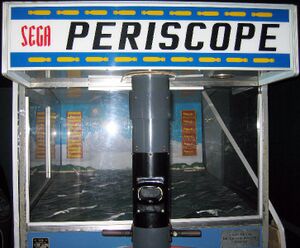Electro-mechanical arcade games
From Sega Retro

Electro-mechanical arcade games (often abbreviated EM games) are what arcades used to have before the invention of solid state electronic games (which use solid-state electronics like transistors, integrated circuits, printed circuit boards and microcontrollers.) An electro-mechanical game is any coin operated game that has neither a microprocessor (nor an approximation of one with logic gates like SHARK Jaws, Computer Space, and others used), or a proper monitor (though some used a projection screen, like Duck Hunt and Killer Shark). An electro-mechanical game is run through switches, relays, motors, and lights. Any electronic circuitry in the machine will be very simple.
The most common type of electro-mechanical games were early Pinball machines—all of them up to the late seventies were electromechanical (the industry switched to microprocessors around 1978 or so). Other electro-mechanicals include most early slot machines and Pachinko machines, although the earliest ones were completely mechanical.
Besides pinball, there were many other types of electro-mechanical games, ranging from sports games to light-gun shooting games. Usually, rather than displaying the objects on a screen, they were physical objects that were either static or moving, often inside a showcase. Eventually, from 1969, there were electro-mechanical games that used projection screens, giving them the appearance of arcade video games.
These games had one big problem: they broke down all the time. This is why you never see any electro-mechanicals anymore (aside from a few really old Skee Ball machines). The mean time between failures on most of these machines could be measured in days. Some were more reliable than others, but in general the more complex ones were constantly failing. Any individual game may have hundreds of moving parts, which were often subject to abuse. This makes functioning electro-mechanicals very rare today.
Screen Projection
Starting with Duck Hunt in January 1969, Sega introduced electro-mechanical arcade games that had the appearance of first-person video games, but were in fact electro-mechanical arcade games that used rear image projection in a manner similar to the ancient Chinese zoetrope to produce moving animations on a screen. Duck Hunt was the first electronic arcade game with animated targets displayed on a screen, in contrast to earlier electro-mechanical arcade games that displayed actual physical static targets. This gave Duck Hunt the appearance of a video game, several years before the first true video games arrived in the arcades (Computer Space and Pong). Duck Hunt thus anticipated the kind of light-gun shooter video games that would later appear in the 1970s, and was the first electronic arcade game to display a first-person perspective on a screen.
After Duck Hunt, Sega produced several more electro-mechanical arcade games based on the same technology, using rear image projection in a manner similar to the ancient Chinese zoetrope to produce moving animations on a screen. In 1969, Sega released the electro-mechanical games Grand Prix, a first-person driving/racing game projecting a forward-scrolling road on a screen, and Missile, a first-person vehicle combat simulation that had a moving film strip project targets on screen and a dual-control scheme where two directional buttons move the player tank and a two-way joystick with a fire button shoots and steers missiles onto oncoming planes, which explode when hit. In 1970, the game was released in North America as S.A.M.I. That same year, Sega released Jet Rocket, a first-person combat flight sim with cockpit controls that could move the player aircraft around a landscape displayed on screen and shoot missiles onto targets that explode when hit. In 1972, Sega released Killer Shark, a first-person light gun game known for appearing in the 1975 film Jaws.
These eventually influenced Nintendo to produce similar light-gun shooting electro-mechanical arcade games. In 1974, Nintendo's arcade light gun shooter Wild Gunman used similar technology, but improved it even further by using full-motion video projection to display live-action cowboy opponents on screen.
Subcategories
This category has the following 16 subcategories, out of 16 total.
1
- 1962 electro-mechanical arcade games
- 1965 electro-mechanical arcade games
- 1966 electro-mechanical arcade games
- 1967 electro-mechanical arcade games
- 1968 electro-mechanical arcade games
- 1969 electro-mechanical arcade games
- 1970 electro-mechanical arcade games
- 1971 electro-mechanical arcade games
- 1972 electro-mechanical arcade games
- 1973 electro-mechanical arcade games
- 1974 electro-mechanical arcade games
- 1975 electro-mechanical arcade games
- 1976 electro-mechanical arcade games
Pages in category "Electro-mechanical arcade games"
The following 72 pages are in this category, out of 72 total.